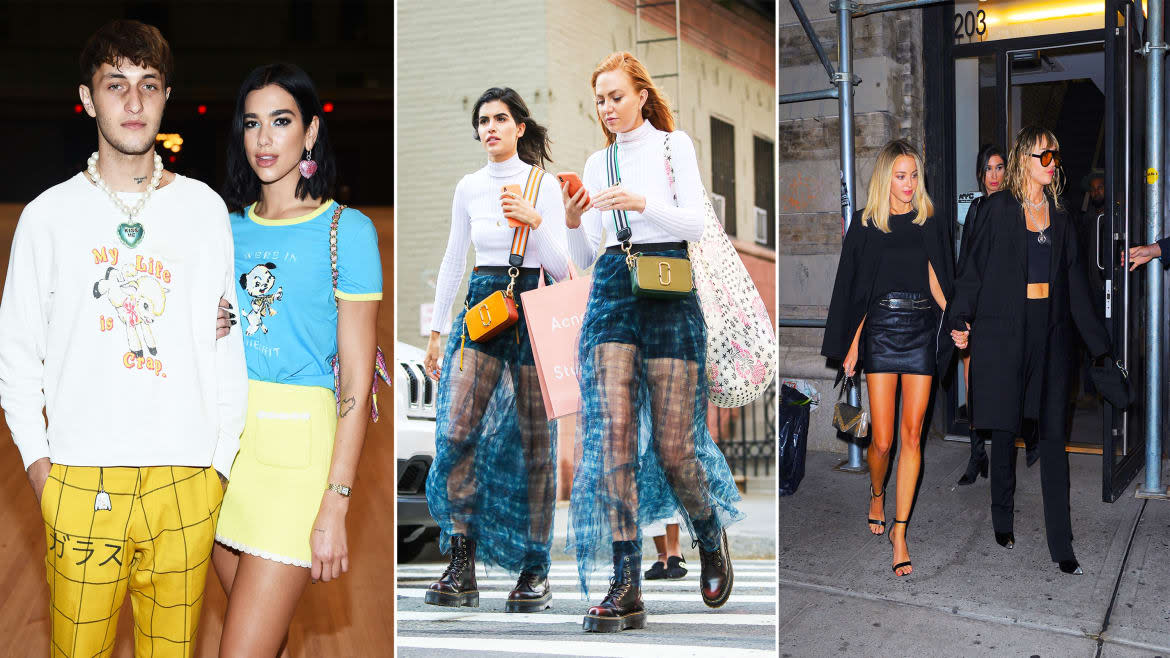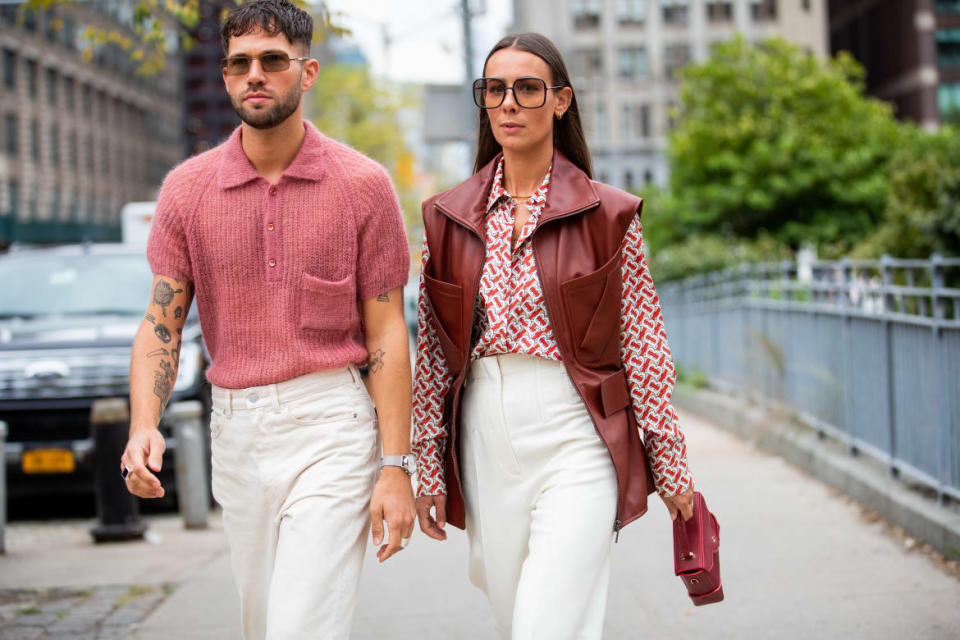The Hottest Accessory Is Someone Dressed Exactly Like You

Fashion Week stomped in and out of New York like Working Girl's Melanie Griffith in her commuter Reeboks (which, incidentally, were seen on a few runways.) Designers championed female empowerment, with more than a few show notes lauding the “strong women” who inspired collections. Muses were mothers, daughters, and sisters.
Heels were (slightly) more manageable than seasons past, with Gigi Hadid even walking barefoot. Women should finally dress for themselves, right down to their underwear, Rihanna commanded.
Marla Maples’ Night of ‘Blurred Gender Boundaries’ at NYFW: Taoray Taoray and RISD
But off the runway, it seemed all women wanted to do was match their partners.
As the New York Post and Daily Mail gleefully reported, Miley Cyrus and her new “bombshell girlfriend” Kaitlynn Carter made out all over New York’s trendiest basements in coordinated all-black ensembles.

Kaitlynn Carter and Miley Cyrus, September 10, 2019, in New York City.
The singer Dua Lipa stepped out for the first time in public with her boyfriend, Anwar Hadid, in harmonized outfits of cartoon T-shirts and candy heart jewelry, looking like two grown adults in children’s clothes trying to sneak into a Chuck E. Cheese birthday party for the free pizza.

Anwar Hadid and Dua Lipa attend the Marc Jacobs Spring 2020 Runway Show at Park Avenue Armory on September 11, 2019 in New York City.
French influencers Alice Barbier and Jean-Sebastien Roques, who simply describe themselves as a “#couple” in their Instagram bio, showed up to a host of shows united in sartorial bliss.

'Couple' Jean-Sebastien Roques and Alice Barbier seen outside Sally LaPointe during New York Fashion Week on September 10, 2019 in New York City.
Of course, women can be happily coupled and retain their own sense of self; wanting to dress like a significant other does not itself signal codependency. But if the #MeToo movement kicked off fashion’s obsession with a liberated, modern women, synchronized ‘fits could be equivalent to Reagan-era resistance of popular feminism.
That said, coordinated dressing is not just for lovers. Plenty of fashion week-ers styled themselves in groups with friends. It could have been a visual (or performative) nod to the value of female camaraderie, or an attempt to communicate they’re in-demand enough to have a squad of their own. Or perhaps we’re all just drawn to people who look like us.
“The psychology behind it is that we’re attracted to what feels familiar, safe, and normal,” Rachel A. Sussman, a New York-based therapist who specializes in relationship issues, told The Daily Beast. “It feels like family. It’s like a tribe. I’m always so interested when I see a new couple; they always look like each other—sometimes they look like brother and sister.”
Sara Covey, a Chicago-based influencer who matched with her friend Alexis May all week, agrees there is something childish about the “youthful” trend. “My mom would always put matching dresses and oversized bows on my older sister and me as we were growing up,” she said. “I really enjoy the nostalgia that it brings, as well as the community it creates. It is a trend that requires a person outside yourself to coordinate with.”
Covey said that most of her “twin outfits” with May have been planned, but some were orchestrated “because we happened to share the same outfit.” During a trip to Hawaii, the pair “unknowingly” packed duplicate hats, pants, and sandals. The only noticeable difference between the two women, who hold hands in the shot, is the length of their hair—mid-length and a lob, respectively, both styled in loose waves.
Ditto for when the pair went to Charleston, South Carolina, both bringing high-rise, straight-cut blue jeans, white tops, and bucket hats. “The outfits were packed separately without knowing that we had brought the same things,” Covey said. Sometimes, she admitted, the coordination is intentional, curated exclusively for the Instagram picture.
“We all want to feel like we belong, like we’re part of a group,” Dawnn Karen, a fashion psychologist and adjunct professor at FIT, said. “Dressing alike can allow this camaraderie that fills this need or desire of belonging. It reminds me of groups—the popular kids, the cool kids.”
Lauren Caruso, site director of The Zoe Report, attended shows alongside her entourage of senior fashion editor Aemilia Madden and contributing senior style editor Mecca James-Williams. On the second day of the week, the team showed up united in shades of pink and orange. “None of us discussed it beforehand,” Caruso said. “It was a happy surprise that made for a great street style moment.”
Showing up to an event wearing the same outfit as someone else used to be a clichéd, if ubiquitous, fear. Friends with dinner plans would share what they planned to wear to ward off any copycats, and young women created Facebook groups where they would call dibs on their preferred prom dresses. No one wanted to be Lucille Ball in Marx Brothers drag, waving at the real Harpo through a “mirror.”
“If you don’t have enough confidence and are coming from a space of insecurity you’re going to be triggered when you see someone in the same outfit,” Karen said. “You’ll feel like your individuality is taken away and you can’t stand out.”
But fashion “rules” are becoming increasingly passé. Just this week, two women attended Cynthia Rowley’s presentation in identical plaid tulle skirts, lavender turtlenecks, and crossbody bags, posing for photos together arm-and-arm, megawatt smiles on their faces.
Still, history treats dual dressing with a touch of the absurd—or creepy (think: Jennifer Jason Leigh cutting her hair to match Bridget Fonda’s in Single White Female).
Twentieth century comedic duos like Laurel and Hardy, the Smothers Brothers, and Penn & Teller wore similar suits. Howard (Stanley Lebor) and Hilda (Geraldine Newman) finished each other's sentences in matching twee knitwear, in the BBC’s Ever Decreasing Circles. Simon and Garfunkel’s matching black turtlenecks on the Bookends album cover has become the stuff of parody, or at least last-minute Halloween costumes.
Same with Britney Spears and Justin Timberlake’s double denim-on-denim 2001 red carpet moment, which has been seared into pop culture history. (In 2016, Spears’ gown sold for over $7000 at auction. The whereabouts of Timberlake’s suit—and questionable fedora—remains unknown.)
As with many things considered unserious by The People In Charge, dressing similarly has become associated with girl culture and young women. Karenn, the fashion psychologist, believes that mindset has less to do with sexism and more to do with the fact that most men are conditioned to dress similarly anyway.
“Guess what, women have more options,” Karenn said. “Men typically look the same; it’s homogeneous, and they naturally dress alike. In general, women will dress alike on purpose, but men will [do so] because it’s what society expects of them.”
Covey, the Chicago influencer, said her “ultimate matching icons” are the Olsen Twins, who were forced into identical costumes since their infancy, when both played Michelle Tanner on the sitcom Full House.
As teens, the two went off to study at New York University, where they were relentlessly followed by paparazzi, who frequently caught them looking alike in the Olsen uniform of a tank top, bootcut jeans, oversized sweater, Starbucks latte, and occasional cigarette. (Remember, it was the mid-aughts.)
More than 30 years later, the two run The Row, a minimalist clothing line which also showed this week. The puffy bows and baggy sweatpants of their past have been replaced with tailored black pants and crisp white button-ups. Still, the spring collection is a revolving door of black and white ensemble that strip models of any semblance of personality. Conformity, it appears, will be so hot this spring.

Guests seen outside 3.1 Phillip Lim during New York Fashion Week, September 9, 2019.
Get our top stories in your inbox every day. Sign up now!
Daily Beast Membership: Beast Inside goes deeper on the stories that matter to you. Learn more.

